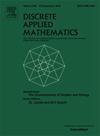The degree sequence of the preferential attachment model
IF 1
3区 数学
Q3 MATHEMATICS, APPLIED
引用次数: 0
Abstract
For the preferential attachment model of random networks, Bollobás et al. proved that when the number of vertices is large enough, the proportion of vertices with degree obeys a power law for all . They asked that how far the result can be extended to degrees . We give an answer by extending the range to all , for any arbitrarily small constant and arbitrarily large constant . The answer is near optimal, since the maximum degree is .
求助全文
约1分钟内获得全文
求助全文
来源期刊

Discrete Applied Mathematics
数学-应用数学
CiteScore
2.30
自引率
9.10%
发文量
422
审稿时长
4.5 months
期刊介绍:
The aim of Discrete Applied Mathematics is to bring together research papers in different areas of algorithmic and applicable discrete mathematics as well as applications of combinatorial mathematics to informatics and various areas of science and technology. Contributions presented to the journal can be research papers, short notes, surveys, and possibly research problems. The "Communications" section will be devoted to the fastest possible publication of recent research results that are checked and recommended for publication by a member of the Editorial Board. The journal will also publish a limited number of book announcements as well as proceedings of conferences. These proceedings will be fully refereed and adhere to the normal standards of the journal.
Potential authors are advised to view the journal and the open calls-for-papers of special issues before submitting their manuscripts. Only high-quality, original work that is within the scope of the journal or the targeted special issue will be considered.
 求助内容:
求助内容: 应助结果提醒方式:
应助结果提醒方式:


